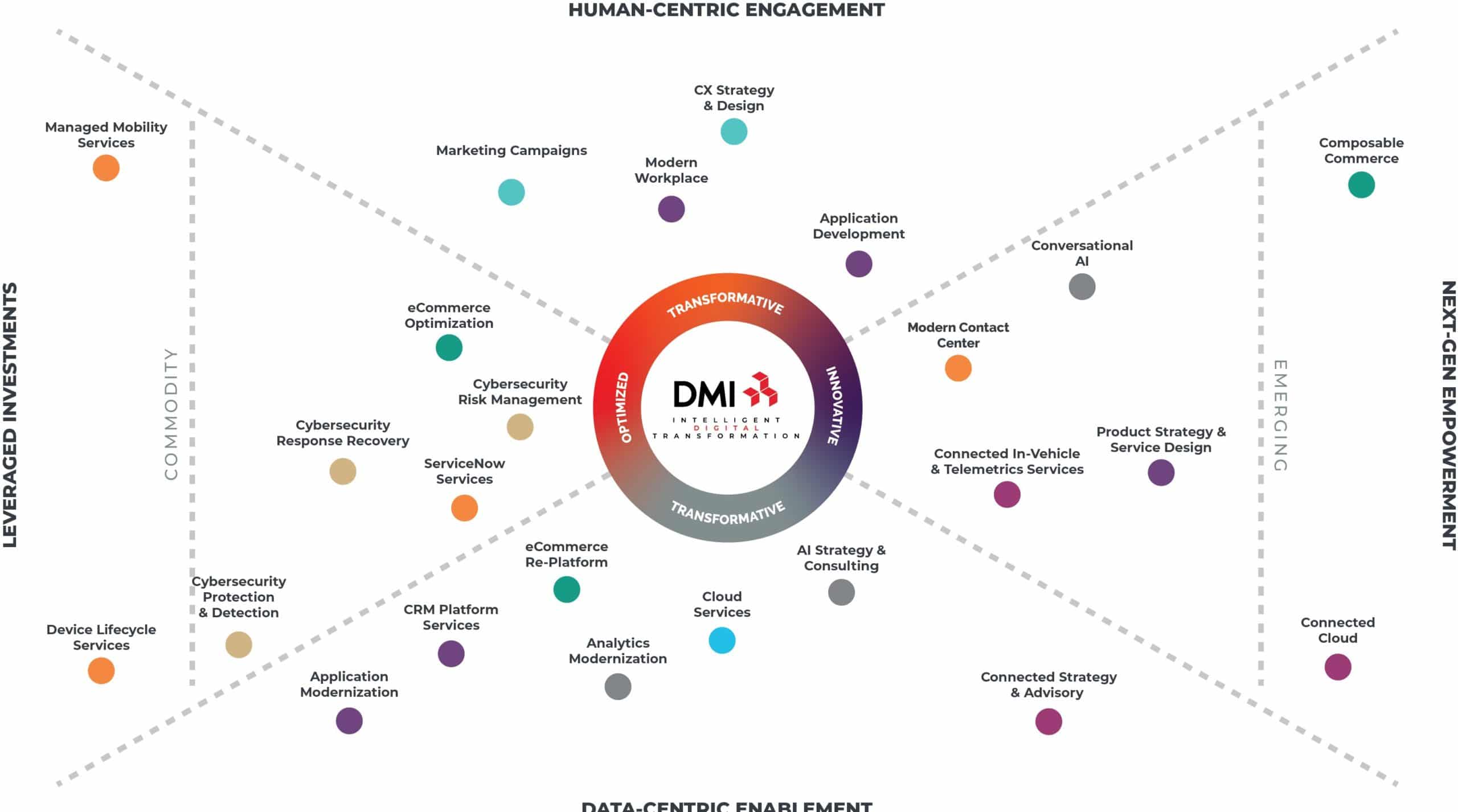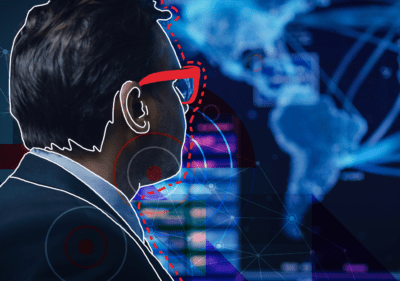What Is Digital Transformation?
 The term “digital transformation” hasn’t been around for very long — five, maybe six years at the most. In that time, it’s gone from a little-known descriptor to a mainstream benchmark for success. But what is digital transformation? Is it a hollow phrase — meaningless tech lingo thrown around to impress — or is it something more?
The term “digital transformation” hasn’t been around for very long — five, maybe six years at the most. In that time, it’s gone from a little-known descriptor to a mainstream benchmark for success. But what is digital transformation? Is it a hollow phrase — meaningless tech lingo thrown around to impress — or is it something more?
We’ll explore those questions, and many others, in this comprehensive guide to digital transformation. Along the way, we’ll introduce two different types of innovation:
- Adoptive innovation: The existing innovative tech products you incorporate into your digital transformation strategy
- Adaptive innovation: The innovation you produce in the creative space beyond digital transformation
The second type of innovation defines transcendence — and by the time you reach the end of this article, you’ll know exactly what that means.
In simple terms, digital transformation happens when companies replace outdated or manual business processes and technologies with new digital technologies. To be more specific, digital transformation changes at least one of the following four parts of an organization:
- Its financial model: New revenue streams, investment strategies or payment options
- Its value proposition: Self-serve purchasing options for consumers, or digital products
- Its capabilities: New business models including, content streaming or advanced distribution initiatives
- Its customer engagement strategy: AI-enabled CRM systems or intelligent product personalization for better customer experience
Some companies draft sweeping digital transformation strategies, make too many changes at once and then stumble into technical oblivion. Others buy new computers, load complex enterprise software packages and end up feeling frustrated when their investments don’t add up to business value and revenue gains.
Digital business transformation isn’t as simple as an off-the-shelf CRM system or a hardware upgrade. Purchasing a prefab mobile solution, for example, won’t transform your business into a digital company.
Bespoke products — and sage advice from a great consulting agency — might cost a little more in the short term, but they boost company value in the medium and long term.
Transformative vs Non-Transformative Companies
 To know where you’re going, you have to know where you’re at. When Gartner talks about digital transformation initiatives and journey planning, it identifies four distinct company profiles, or classes: enablement, optimization, transformation and industry vision.
To know where you’re going, you have to know where you’re at. When Gartner talks about digital transformation initiatives and journey planning, it identifies four distinct company profiles, or classes: enablement, optimization, transformation and industry vision.
Enablement Class
Enablement-class companies are essentially stagnant. Tech costs are high, but not for the right reasons; outdated software and obsolete hardware cause problems and need attention constantly. Digital technology is seen as a stumbling block rather than a helpful addition to the business.
Tech-friendly executives at enablement-class companies find it hard to introduce meaningful optimization strategies to their business processes. Support for digital transformation initiatives is nonexistent. To achieve change, IT leaders at enablement-class companies have to start with the basics: reliable IT systems, mobile computing and cloud storage, for instance.
Optimization Class
Optimization-class companies sit further along the transformation timeline than enablement-class companies, but they’re not yet at an inflection point. They don’t yet have a digital transformation strategy; they do, however, keep track of IT developments and future opportunities to disrupt.
Business leaders at optimization-class companies focus mainly on optimizing their current business models. They lead initiatives to improve customer experience, boost productivity and use assets more efficiently. Full-scale digital transformation is beyond the horizon.
Transformation Class
In basic terms, transformation-class companies are early adopters. They integrate and implement suitable emerging technologies to get ahead of the pack, and actively invest in digital transformation. Most transformation-class companies upgrade by department and don’t cling to legacy tech.
Transformation-class companies don’t optimize existing models as much as optimization-class companies. Instead, they embrace new digital technologies and believe cutting-edge developments represent the best opportunity to grow. They accordingly dedicate a significant proportion of their annual IT budgets to digital transformation efforts.
Industry Vision Class
Industry vision-class companies “live” one step beyond digital transformation. Instead of adopting hardware and software products created by other companies, they develop brand-new digital technologies and make money by driving successful digital transformation.
As sector leaders, industry vision-class companies have almost no legacy tech on site at all. They lobby regulators and use aggressive marketing tactics to push their products onto the market. Simply put, industry vision-class companies actively try to force transformational tipping points in their industries.
The Digital Transformation S Curve
It can help to imagine digital transformation efforts happening along an S curve. An industry paradigm S curve defines timing. It begins on the left, slopes up toward the right and reaches an apex, or tipping point, before cycling into the next S curve.
The S curve is a snippet — it’s just one section of a never-ending developmental timeline that repeats over and over again.

Optimization
Optimization happens along the upward slope of an S curve. Companies in the optimization phase don’t make wholesale technological changes; instead, they hone and modernize their existing hardware and software.
Optimization takes a current business model to the limit of what it’s capable of — and it’s an essential step toward transformation. Without an optimization phase, digital transformation doesn’t usually succeed.
Transformation
Transformation happens at the apex of an S curve — the very top. When companies transform, they adopt new technologies and expand into new areas. Previously non-digital companies implement digital services, for instance, while digital businesses start using AI-integrated programs.
Innovation
Innovation takes place beyond the horizon of the S curve. Companies at this point drive change intentionally and seek to transform the industries they’re based in. These businesses develop brand-new digital products, new business models, and groundbreaking methodologies — in effect, they become visionaries and the ones who start digital transformation trends.
So, how do you know where you are on the S curve? The simplest way to tell is to look at your rate of growth. If your company is growing at a stable rate, it makes sense to optimize your current tech as much as possible before adopting a transformation strategy.
One caveat: If the industry you’re in is moving toward a tipping point — a point at which transformation is inevitable — you need to change and start your digital transformation initiative to avoid being left behind.
What Is Intelligent Digital Transformation?
In short, intelligent digital transformation is AI-enabled digital transformation. Artificial intelligence isn’t a short-term fad in the digital transformation arena — instead, it’s an emulsifier.
Until quite recently, digital and physical technologies were distinct from one another. They sat next to each other like oil and water. The addition of AI facilitates an emulsion — a physical and digital blend, if you like.
Digital and physical convergence based on AI began happening well before the pandemic, but COVID-19 accelerated the rate of industry change. IoT-based and AI-based technologies suddenly came to the fore as coronavirus spread around the world. Enhanced machine learning models made Instacart grocery deliveries more reliable; QR codes replaced restaurant wait staff; AI algorithms in the lab suggested new experimental COVID-19 treatments.
The more digital and physical worlds collide, the more we need AI for digital transformations. API-based composable enterprises, for instance, benefit especially from the addition of artificial intelligence. Virtual reality (VR) and augmented reality (AR) programs help consumers envision everything from jewelry to new furniture and exercise equipment in situ.
Here at DMI, we believe that wholesale AI integration — AI in every platform — is the future. Recently, we added AI to a picture-taking solution in a program called Inspection Platform. Inspection Platform evolved into the Auto AI platform, a machine learning-enabled program capable of automatically capturing vehicles to dealer specification.
In conjunction with human input, AI-enhanced technologies improve decision-making and streamline workflows. That, in a nutshell, is intelligent digital transformation.
Why You Can’t Ignore Digital Transformation
Why should you invest in digital transformation services when the status quo feels comfortable? Theoretically, you can ignore digital transformation — but if you do, your company will eventually fall off the back end of the S curve and go out of business.
There are so many good reasons to invest in new digital technology. With a solid digital transformation strategy, you can:
- Optimize your current tech and processes. With better tech and better processes in place, you’ll maximize what you can do with your annual company budget.
- Onboard new processes you like. Well-designed processes make workers happier. Happier workers stick around, so you’ll reduce your staff turnover and hiring costs.
- Transform continuously. You could move beyond transformation and become an industry leader — a vision class enterprise, in other words.
- Boost revenue. AI-based procurement systems, for instance, streamline supply chains and optimize inventory flow.
- Improve productivity. The right systems for your company take your service blueprint into account and improve productivity while reducing costs.
- Elevate CX. Digital products like virtual assistants and self-serve options can really improve the customer experience.
- Reduce waste. IoT and digital technologies make inventory tracking easier and help improve asset utilization.
The DMI Difference
DMI’s definition of digital transformation is a little different from the standard three-step description above. At DMI, we view digital transformation through the lens of convergence. In fact, we use something called the DMI Convergence Model to explain how digital transformation happens.
In the DMI Convergence Model, digital transformation happens continuously. Optimization, transformation and innovation all exist in a single space, where they merge with data and human experience to create change.
“You can’t have digital transformation without an optimization phase. Optimization creates a technological foundation — a central core — which supports transformation.”
— Jesse Humphrey, DMI
At DMI, we meet clients where they are. We teach them about digital transformation in general, and then we guide them through their own transformative journeys. We don’t just provide advice about what needs to change, we also talk about how things change — in effect, what needs to occur for digital transformations to manifest.
The DMI Convergence Model

Conversations about digital transformation often revolve around methodologies like DevOps — tactics for change. Human beings get forgotten in the midst of tech chatter.
Transformation is human- and data-centric, and at DMI, we aim to bridge the gap between tactics and people. That’s where the DMI Convergence Model comes in. Every one of our clients must transition to transform, and finally to transcend. The Convergence Model is a holistic framework that includes all three phases of digital transformation — plus human input and data.
In the Convergence Model, obsolete processes and technologies fall off on the left, and new processes and technologies come in on the right. Data-centric and human-centric factors also merge into the Convergence Model — stream into the melting pot, so to speak.
Transformation happens when these four factors combine in the middle of the Convergence Model, which encompasses a never-ending swirl of activity. When we use the Convergence Model to drive organizational change, our clients gain an enhanced work experience aligned precisely with their service blueprint.
Let’s explore a typical digital transformation journey at DMI:
Phase 1: Optimization
Optimization is something you do to existing systems to prepare them for transformation. Which processes and systems work, and which don’t? Are current enterprise programs effective — if not, why not? At DMI, we talk about optimization from a human perspective — technology follows later. We gather data and explore anecdotal experiences; then, we use both forms of information plus available technologies to draft a digital transformation blueprint.
Phase 2: Transformation
This is where the magic happens — right in the middle of the Convergence Model. This phase is the tech equivalent of a rockpool full of primordial soup, and it never stops. Optimization continues to happen; companies adopt new human interfaces; data flows in; adjustments occur. At the same time, we look ahead and consider which innovative technologies to weave into the transformational flow.
Phase 3: Innovation
Innovation happens at the leading edge of the Convergence Model. Businesses develop advanced AI-based programs, proprietary enterprise technologies and industry-leading tech products. At this stage, they’re leaders, rather than followers.
Digital Transformation Is a Human Process
Digital transformation is all about people — it’s about making things work for human beings. To transform successfully, companies have to think about processes from a human perspective to improve client and customer experience.
People have roles within organizations. Organizations, or systems, use processes to achieve specific results — and some of those processes are opaque and hard to understand. Most people aren’t interested in how processes and new technologies work — they simply want to achieve a particular outcome.
“Technology is built for humans, and not the other way around; transformation is about making things function for people.”
— Mike Diettrick, DMI
Most end users aren’t technical. They find IT frustrating — especially when it doesn’t work properly — and imagine innovation as a hindrance, rather than a path forward. Optimization and transformation are pointless exercises if they don’t improve the human experience.
At DMI, we show people how technologies help them achieve success in the workplace. We believe humans drive digital transformation and shape the business outcome. Change is tangible, which is why we focus on transformation when we speak to people. Human beings experience transformation more than either of the other two Convergence Model stages.
“People don’t experience innovation and they don’t experience optimization, either, but they do experience transformation. That’s why the focus is on transformation: it’s the one thing they experience.”
— MD
What About AI?
The DMI Convergence Model revolves around human input — so what happens when we add AI? Do we remove or reduce the human experience when we bring in AI and Robotic Process Automation?
We don’t think so. In fact, we’d argue that AI-enabled bots have experiences of their own. To function efficiently, they have to behave like human beings. Bots don’t have emotions, but they still learn and grow accordingly. They gather relevant data and modify behaviors based on new information, just like people do.
AI developers give bots names — Rex, Cortana, Alexa and DeepMind, for instance — because they emulate human beings. They’re not human, though — and human beings are not replaceable.
We can leverage AI in the workplace by infusing human input and business-centric information into machine learning innovation. When we do this, we gain insight and a very useful AI helper.
What Does Digital Transformation Look Like?
 Now that we’ve explained what digital transformation is, and what the DMI version of digital transformation means, let’s explore what digital transformation actually looks like.
Now that we’ve explained what digital transformation is, and what the DMI version of digital transformation means, let’s explore what digital transformation actually looks like.
A company and its industry both need to be taken into account when crafting a digital strategy. For instance, if a company doesn’t yet want to transform but its industry is transforming, strategy redevelopment becomes essential.
With that said, transformation always happens in the context of the customer and their company, and not in the context of the entire market. Something that is innovative to one business might not be innovative to another business — AI, for instance. During digital transformation, you borrow, rather than drive, innovation.
Digital Transformation Is a Collaborative Project
“Models don’t transform culture: engagement does.”
— MD
Bringing DMI on board for a vision-centric digital transformation session is unlikely to succeed unless you get everyone on board first — and we mean everyone, from board members to the people working on your shop floor or in your factory. All of you should take part in your organization’s digital transformation strategy and need to be aware of — and enthusiastic about — what’s going to happen.
Your executives and employees also need to understand how valuable they are, and how much their individual contributions drive overall company success. They also need to appreciate their colleagues’ roles within the business.
At DMI, custom digital strategy development begins with dialog. We bring IT professionals, finance mavens, HR managers and other contributors at your company together and show them how they can use new tools to achieve common goals. We explain how they each fit into the transformative model, and how they can help boost growth, increase company revenue and kindle innovation.
“Intelligent digital transformation isn’t just about digital technology — it’s also about human intelligence as well. We want to leverage the capabilities, expertise and experience of DMI personnel and experts at the companies we serve as we build our solutions. After we’re gone, our clients can continue to use that culture we create to propel themselves forward.”
— JH
Determining Where to Begin
Digital strategy is an essential part of any modern business plan. In the DMI Convergence Model, optimization, transformation and innovation all converge. To formulate a digital transformation plan and begin your journey, you have to determine what type of company you are right now.
First, you need to assess your current status. Do you currently dedicate a portion of your IT budget to optimization, and if so, how much? After that, you need to define what you want digital transformation to do for your company. How do you plan to change for the better? Do you want to improve CX or use resources more efficiently?
With a clear picture of your current circumstances and a set of solid goals in mind, you can move on to the planning stage.
Striking a Balance Inside the Convergence Model
You don’t have to shed your skin and slip into a new one to optimize what you have, and you don’t have to throw away all your existing tech to transform — in fact, few companies do. To thrive in the center of the Convergence Model, you do have to learn how to optimize and onboard adoptive innovation at the same time.
Some things go away when you enter the transformation zone, while others stay and get optimized. Which existing elements stay and which go depend on human input and data, both of which also flow into the center of the Convergence Model.
“Transformation is perpetual — it never stops.”
— MD
DMI can help you adopt any innovative technology you want to try, and we can optimize any existing system you have. We can also make recommendations about releasing obsolete tech, or technologies that don’t jive with your goals or your company paradigm.
Here’s what a consultation with DMI typically looks like:
- We talk about transformational phases to determine where you are right now. If you want to move out of an enablement phase and into an optimization phase, for instance, we talk about what needs to happen to make that vision a reality.
- We discuss current operational costs and determine where your company budget goes. How much do you spend on IT, and how much of that do you dedicate to optimization and innovation?
- We explore available data, and we talk about how to gather information effectively.
- We define optimization from a practical perspective and make a list of obsolete and underused tech. Are you getting the most out of your CRM, for example? If not, why not?
- We decide which systems and processes can stay, which need to go and what we can replace them all with.
- We teach clients about the Convergence Model and help them understand digital transformation drivers.
Every company’s digital transformation is unique. Digital transformation plans sometimes include:
- Bringing in CRM systems for the first time
- Developing AR-enabled mobile apps to help consumers visualize products
- Going from human-staffed call centers to text-and-AI-based, improving customer service departments
- Swapping PBX systems for cloud-based communications platforms
- Adopting IoT-integrated inventory tracking systems
The DMI VisionNEXT Continuous Strategy Framework
“Digital transformation does not occur without cultural transformation.”
— MD
 Some digital transformations fail — dramatically. Companies adopt methodologies like DevOps and Agile without seeking independent advice; then, they enthusiastically build the wrong systems the right way. They spend thousands on unsuitable custom tech and end up feeling frustrated and angry.
Some digital transformations fail — dramatically. Companies adopt methodologies like DevOps and Agile without seeking independent advice; then, they enthusiastically build the wrong systems the right way. They spend thousands on unsuitable custom tech and end up feeling frustrated and angry.
At DMI, we help clients build the right systems the right way. We translate tech language into business language — and vice versa. When programmers understand what businesspeople need, they build better programs more efficiently. We use our VisionNEXT Persuasion, Influence and Change (PIC) framework to help clients formulate human-centric digital transformation strategies — and we talk about digital products, rather than digital projects.
Other companies create journey maps; at DMI, we build product-based solutions that align precisely with our clients’ service blueprints. We provide our clients with all the technologies they need to operate efficiently in a digital landscape, and we alter the company’s operational culture at the same time.
The DMI journey concludes with our empowering VisionNEXT Adoption, Compliance and Empowerment (ACE) framework. With an ACE framework in place, our clients can continue to transform and innovate independently after we’re gone.
Transcendence: Going Beyond Digital Transformation
What comes next — after digital transformation? Some companies continue to optimize and transform. They stay at the front of the industry pack and adopt efficient 60:30:10 budgeting ratios. Others build bespoke systems and propel themselves forward into the innovation space.
Innovation is all about transcendence. It requires an understanding of what you have and a willingness to move beyond that into new territory. Technical innovation goes in; business innovation comes out. Innovators usually go with a 50:30:20 budget, where 50% of the budget goes toward operational costs, 30% goes toward company growth and 20% goes into innovation.
Apple, Amazon and Alphabet are all 30:30:10 companies — in other words, they’re innovators. They no longer consume innovative products made by other companies; instead, they innovate and drive change on purpose.
Why innovate rather than consume? Well, if you get it right, you could make a lot of money. Successful innovators gain the ultimate competitive advantage over industry peers. They exist in multiple spaces at once and regularly disrupt entire sectors.
“The goal of digital transformation is to become perpetually more innovative. Optimization becomes simpler and easier as you go, and innovation becomes the focus of the company, to gain competitive advantage.”
— Mike Diettrick, DMI
Transform with DMI
Optimization is always the first step in any digital transformation strategy. Companies have to optimize their existing processes before they enter transformation mode. Optimization can help businesses identify transformation opportunities — but in itself, optimization isn’t transformation.
Optimization improves, rather than transforms, the human experience. When you gather a new type of data or change your platform interface, for instance, that’s optimization, rather than transformation. Transformation and innovation, on the other hand, greatly improve efficiency and make your business faster, better and more cost-effective than before.
DMI is all about people. At DMI, we approach digital transformation from a human perspective. We design processes and programs to work lockstep with your company blueprint, and we aren’t satisfied until you are. To find out more about what DMI can do for you, or to speak to one of our transformation experts, call us on 855-918-0034 or connect online today.


